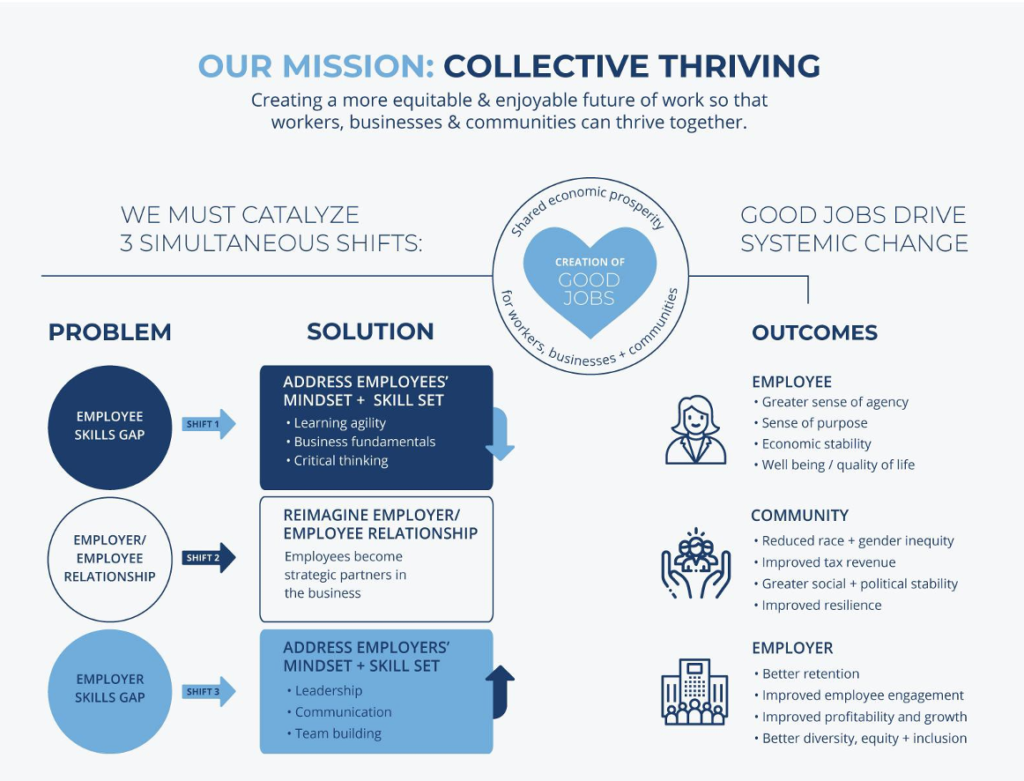It’s been called the Great Resignation, the Great Reassessment, even an opportunity for a Great Retention.
I have another suggestion for naming the upheaval under way in how employees, organizations, elected leaders, and investors are thinking about the way we work: the Great Workplace Reinvention.
I think “reinvention” is a helpful term for understanding what’s happening now—and what’s possible.
It’s too simplistic to say people are resigning from their jobs en masse. Although some Americans seemed to choose more generous unemployment insurance rather than urgently seek new work, that’s not the whole story. In fact, evidence suggests that cutting off those bigger benefits did not prompt workers to rush back to work.
Instead, people are reassessing what work means to them. The pandemic, racial reckoning, political turmoil, and the ravages of climate change are all prompting reflection about personal purpose, collective responsibility, and how jobs align with deeper priorities.
But it’s not just workers who are assessing and reflecting. So are companies, public officials, and investors. I see something more interesting and profound happening.
All these stakeholder groups are refashioning their relationship with work and business. They are actively, in real time, experimenting with the social contract that has governed employment in America for most of the past century. They are tinkering with the very foundations of our economy.
And that gives me hope.
I believe we are witnessing a long-overdue rebalancing of interests and influence. And as employees use their new-found voices – and leverage – in this moment, I see the prospect of reform that will allow all workers to grow into their potential, enable organizations to thrive, and produce shared, sustainable prosperity for society at large.
The pandemic prompts reflection
Everyday employees kicked off this process of reinvention. They are looking to change jobs – a striking 65 percent of employees are doing so.
What the pandemic provided was an opportunity for people who received unemployment benefits (that, in some cases, exceeded their typical paycheck), as well as for many people who continued working, to reevaluate their lives, the things that matter to them, and how they want to spend their time.
And no wonder. Decades of declining job quality have left many people with low wages, little say over their work, and few opportunities for growth or upward mobility.
A “good job” provides personal and professional development, fair pay, purposeful work, a sense of belonging, and a feeling of dignity.
Creating good jobs in the growing “gig” economy is part of the reinvention of work under way. Some freelancers love their flexibility and independence. But many elements of a good job are out of reach for gig workers. Despite the growing number of workers engaged in this newer sector of the economy, we haven’t yet figured out how to make it work for all parties.
Workers seeking a full suite of positive job benefits have typically had to turn to large companies. But approximately 20 million workers in the US are employed by businesses with fewer than 20 employees. Many of these employees don’t have a college degree and have little prospect for higher-wage employment. Among low-wage workers, nearly 54% are women and 45% people of color. If we could transform these jobs into good jobs with opportunities for continued professional growth, perhaps we could begin to close equity gaps in America, while enhancing the vitality of small businesses.
In a project newly funded by my organization, IRC4HR, researchers Jennifer Gresham and Ellen Frank-Miller are exploring how small businesses can create good jobs and contribute to what they call “Collective Thriving.” Jen and Ellen are taking a systems view of this challenge (see Figure 1.) and will be tackling workers’ and employers’ mindsets and skillsets while reimagining the employer-worker relationship.

Where are the workers?
While millions of people are seeking better jobs, business leaders are sounding alarms. Among the many articles and studies on “The Great Resignation” was a recent Deloitte report that noted talent supply is a major concern for business leaders today. From the report: “seven in 10 employers globally [say] they are struggling to find workers with the right mix of technical skills and human capabilities.”
Yes, there is a mismatch between the demand and supply of various skills and capabilities, and a need to better align our education system with the needs of the job market. At the same time, when I hear business leaders complain of a “talent shortage,” one of my first responses is “really?” Are you sure it’s a shortage of talent? Could it be a wage issue? Are you a “high road” employer that treats employees with dignity? Do they have agency, flexibility, and opportunity to develop the skills and capabilities you value? Have you helped them see how their work connects to the broader goals and mission of your organizations? Are you even looking in the right places to find them?
Today’s recruiting practices and related technology solutions filter out a lot of potential talent. These “hidden workers” are eager for jobs but haven’t found a way to overcome challenges including skills and capabilities they have that don’t match the precise language of the automated filtering/ranking process, educational degrees that are part of standard job descriptions but often not required to perform the work, caregiving duties, and language barriers.
But leading companies are forging new programs to uncover missed talent pools, close skill gaps, and improve diversity. That’s the conclusion of a new report, Hidden workers: Untapped talent, co-authored by IRC4HR board member Eva Sage-Gavin of Accenture. The authors explore how companies can benefit from often-overlooked talent such as veterans, the previously incarcerated, and people with disabilities.
Organizations across the economy are moving in this direction, and they are reporting an attractive return on their investment. From the study: companies that purposely hire hidden workers “report being 36% less likely to face talent and skills shortages compared to companies that do not hire hidden workers. And they indicate former hidden workers outperform their peers materially on six key evaluative criteria—attitude and work ethic, productivity, quality of work, engagement, attendance, and innovation.”
A new view of employees
Corporate programs to expand opportunities for historically marginalized groups are encouraging elements of the reinvention of workplaces that is under way.
These initiatives also signal to me that a subtle shift in the balance of power is taking place in this moment. For decades, we have seen the position of workers weakened in the workplace. But employees are finding their voice and recognizing the clout they can have through joint efforts.
It’s encouraging to see high tech workers banding together to raise concerns, ranging from pay to workplace harassment. Collective employee efforts at icons Google and Apple are a sign that employers may want to adopt a suggestion from USC professor John Boudreau. He argues organizations ought to view employees today akin to the way they now view customers—not just as buyers but as collaborators and recipients of great service.
“The goal is to better understand the evolving needs and desires of workers, rather than how to dictate the terms of employment or other work relationships,” Boudreau wrote on LinkedIn recently. “It is helpful to ‘Retool’ this HR issue, by using the analogy of customer relationships, but reframed with work as a ‘product’ and the worker as the ‘customer.’”
Government action also is part of the Great Workplace Reinvention. Georgetown University professor Harry Holzer calls for a variety of government interventions to increase both worker power and employee skills in a recent essay in The Hill. His suggestions range from taxing worker displacement and subsidizing retraining to giving tax breaks and technical assistance to companies with “high road” practices such as higher wages and generous benefits.
Already, we’re seeing elected officials play a more assertive role in reshaping the social contract around work. The extended, increased unemployment benefits during the pandemic were one major example. And proposed legislation could more permanently alter the employment landscape. The push to increase the national minimum wage to $15 per hour is one such measure. Although some business groups warn it will cost jobs, others view it as having the potential to dramatically reduce racial and gender inequity.
Meanwhile, the bipartisan $1 trillion infrastructure bill working its way through Congress would signal government willingness to put Americans to work on a scale not seen since perhaps the New Deal public works projects.
Investors weigh in on the workplace
It’s not just elected officials, employers, and employees who are reinventing workplaces today. Investors increasingly are weighing in on the matter. Thanks in part to a 2020 U.S. Securities and Exchange Commission requirement that publicly traded companies disclose information on human capital, the investment community has been putting a spotlight on matters including the development, safety, engagement, diversity, and retention of employees.
The treatment and welfare of employees is part of a wider movement on the part of investors to look at companies’ environmental, social, and governance metrics. Two years ago, this ESG emphasis, along with societal pressures for companies to be better corporate citizens, led the Business Roundtable to abandon the shareholder-primacy mindset in favor of a “stakeholder” model.
There’s a debate today over whether that shift was just lip service, and whether the ESG field is a “dangerous placebo” that obscures the damage capitalism is doing. Count me among those who see value in stakeholder capitalism, ESG metrics, and increasing human capital disclosures.
In particular, I agree with a recent Fortune essay by Martin Whittaker and Peter Georgescu of JUST Capital, a non-profit firm that conducts research and rankings to help companies measure and improve their performance in the stakeholder economy. Whittaker and Georgescu wrote that stakeholder capitalism “represents a more evolved form of capitalism that creates good jobs and empowers workers; that provides for upward economic mobility and equality of opportunity for all; that builds healthy, prosperous communities and safeguards our planet; and that supports profitable businesses, integrity of leadership, and long-term investor returns.”
From reinvention to movement?
So, the Great Workplace Reinvention is under way. And it seems promising. But how can we accelerate it? What will it take for each of the stakeholder groups to recognize they are parts of wider systems? For organizations to move away from zero-sum thinking and “ego-system” leadership to an “eco-system” mindset?
I believe it will take a movement. Stay tuned—I’ll share more about this in my next blog.
Jodi Starkman is Executive Director of the Innovation Resource Center for Human Resources.

